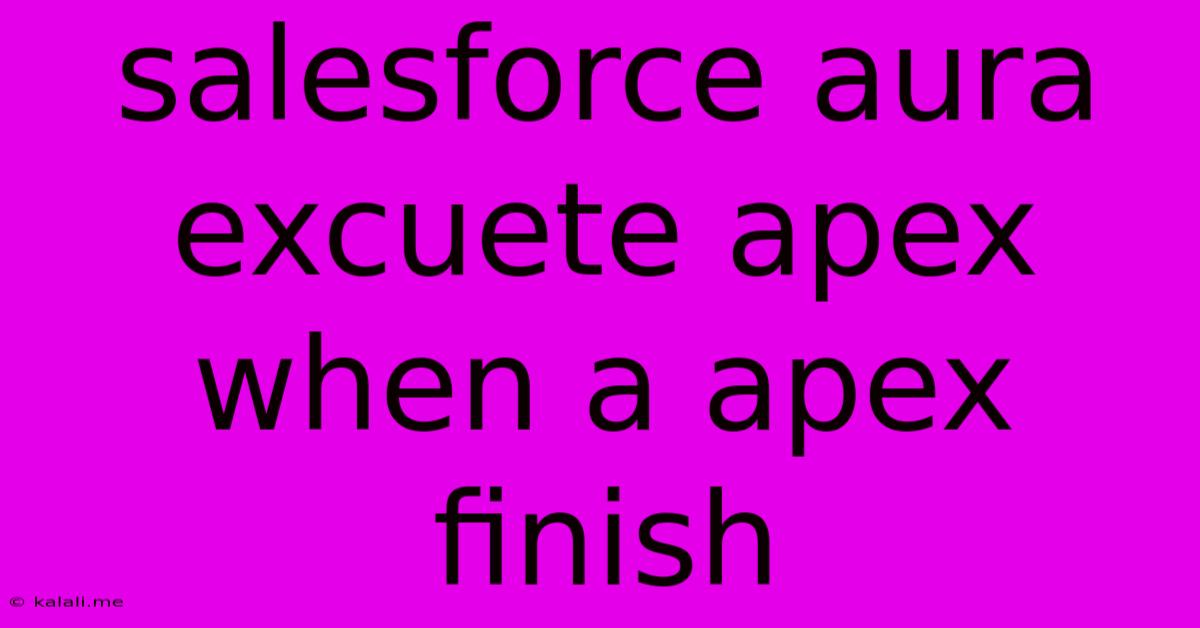Salesforce Aura Excuete Apex When A Apex Finish
Kalali
May 23, 2025 · 3 min read

Table of Contents
Salesforce Aura: Executing Apex and Handling Completion
This article delves into the intricacies of executing Apex from Salesforce Aura components and effectively managing the completion of those Apex calls. Understanding this process is crucial for building responsive and efficient Lightning Web Components (LWCs). While LWCs are the recommended approach for new development, many organizations still utilize Aura components, and mastering Apex integration within them remains relevant. This guide will walk you through the process, addressing common challenges and best practices.
Understanding the Client-Server Interaction
Salesforce Aura components operate on a client-server architecture. The Aura framework running in the user's browser communicates with the Salesforce server using Apex controllers. When an Aura component needs to perform server-side logic (like database operations or complex calculations), it makes an Apex call. This interaction involves several steps:
- Client-side Action: The Aura component initiates an action (usually a controller action in Apex).
- Server-Side Processing: The Apex controller executes the requested code on the Salesforce server.
- Server-Side Response: The Apex controller sends a response back to the Aura component.
- Client-Side Rendering: The Aura component receives the response and updates its UI accordingly.
Executing Apex from Aura Components
The primary mechanism for executing Apex from Aura components is the c:methodName syntax within the controller's serverAction attribute, within the component's definition. This action is then invoked using $A.get("e.c:eventName").fire() where eventName maps to the server-side action.
Handling Apex Completion Successfully
Effective handling of Apex completion is crucial for a smooth user experience. Here's how to achieve this:
- Using
$A.getCallback(): This method is essential for handling asynchronous operations like Apex calls. It ensures that code executes after the Apex call completes. The callback function receives a response object containing the Apex controller's return value or any errors encountered.
// Example Aura Component JavaScript Controller
({
myAction : function(component, event, helper) {
var action = component.get("c.myApexMethod");
action.setParams({
param1 : component.get("v.param1")
});
action.setCallback(this, function(response) {
var state = response.getState();
if (state === "SUCCESS") {
// Process successful response
var result = response.getReturnValue();
component.set("v.result", result);
} else if (state === "INCOMPLETE") {
// Handle incomplete response
console.error("Incomplete response from server.");
} else if (state === "ERROR") {
// Handle error response
var errors = response.getError();
console.error("Error: ", errors);
}
});
$A.enqueueAction(action);
}
})
-
Error Handling: Always include comprehensive error handling to gracefully manage potential issues. Check the
response.getState()and handleERRORandINCOMPLETEstates appropriately. Display user-friendly error messages instead of raw error objects. -
$A.enqueueAction: This method ensures that multiple Apex calls are processed sequentially, preventing race conditions and improving performance. It's essential for complex scenarios involving multiple dependent Apex calls. -
Loading Indicators: Provide visual feedback to the user while the Apex call is in progress. This improves the user experience by letting them know the system is working and prevents frustration. A simple spinner or loading message is often sufficient.
Best Practices for Efficient Apex Calls from Aura
- Optimize Apex Code: Ensure your Apex code is efficient and optimized to minimize execution time.
- Bulkify Queries: Use SOQL queries efficiently to retrieve only necessary data.
- Avoid unnecessary calls: Consolidate multiple Apex calls where possible to reduce overhead.
- Use appropriate data structures: Return data in a structured format (e.g., JSON) for easier processing on the client-side.
By carefully implementing these strategies and utilizing best practices, you can build robust and efficient Aura components that seamlessly integrate with Apex controllers. Remember to thoroughly test your components to ensure they handle various scenarios, including network issues and server errors. While LWC is the future, mastering Aura and Apex integration remains a valuable skill for Salesforce developers working with existing applications.
Latest Posts
Latest Posts
-
How Many Grams Of Sugar In A Pound
Jul 12, 2025
-
7am To 11am Is How Many Hours
Jul 12, 2025
-
If Your 35 What Year Was You Born
Jul 12, 2025
-
How Many Cups Is 1 Pound Of Cheese
Jul 12, 2025
-
30 X 30 Is How Many Square Feet
Jul 12, 2025
Related Post
Thank you for visiting our website which covers about Salesforce Aura Excuete Apex When A Apex Finish . We hope the information provided has been useful to you. Feel free to contact us if you have any questions or need further assistance. See you next time and don't miss to bookmark.